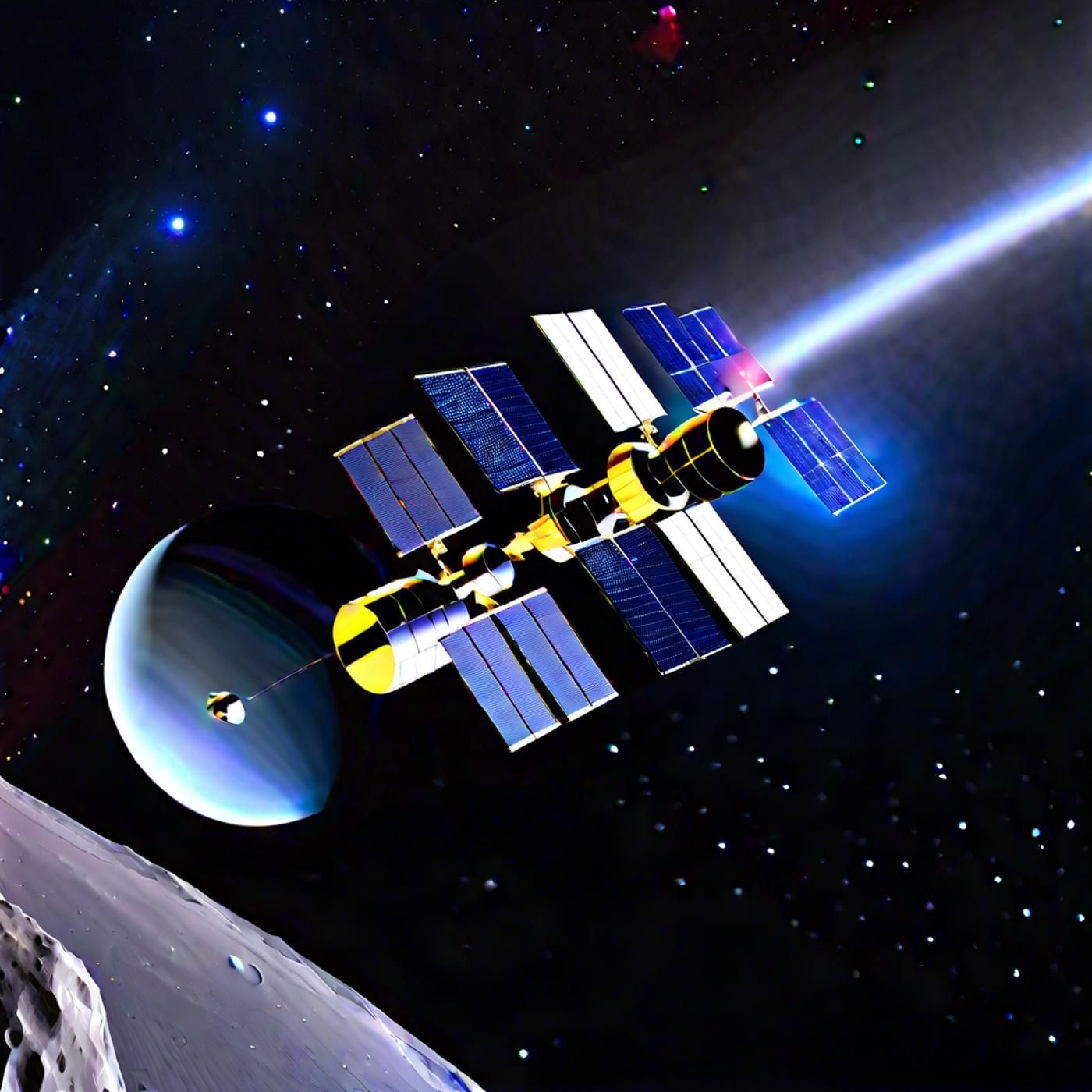S03E81: NASA's Asteroid Defense & Marsquake Water Discovery
Embark on a celestial journey with today's episode of Astronomy Daily - The Podcast, where your host, Anna, brings you the latest cosmic updates. We'll delve into NASA's latest asteroid impact exercise, groundbreaking research on Martian water...
Embark on a celestial journey with today's episode of Astronomy Daily - The Podcast, where your host, Anna, brings you the latest cosmic updates. We'll delve into NASA's latest asteroid impact exercise, groundbreaking research on Martian water detection, DARPA's new quantum laser project, intriguing air samples gathered by Perseverance, and celebrate the Hubble Space Telescope's 21st anniversary with stunning images. Plus, we'll look at recent research focusing on heart failure in space. Let's dive right in.NASA recently released a summary of the fifth biennial planetary defense interagency tabletop exercise, aimed at exploring our preparedness for potential asteroid threats. Organized by NASA's Planetary Defense Coordination Office in partnership with FEMA and the US Department of State Office of Space Affairs, this exercise aimed to assess and enhance our national response capabilities. Despite having no significant asteroid impact threats on the horizon, these hypothetical exercises are invaluable, providing insights into potential risks and response strategies for varying scenarios. This year's exercise involved a newly identified asteroid with a 72% chance of hitting Earth in 14 years. Nearly 100 representatives from US government agencies and international collaborators convened at the Johns Hopkins Applied Physics Laboratory in Maryland for the exercise. The next steps include publishing a complete after-action report detailing the identified strengths and gaps and offering recommendations for improvement.In an exciting development, researchers believe that marsquakes could offer a new method for detecting liquid water deep underground on Mars. This intriguing possibility lies in the unique electromagnetic signals these quakes produce as they traverse Mars' subsurface. Traditional methods, such as ground-penetrating radar used on Earth, aren't effective at the depths where water might exist on Mars. But marsquakes could change that. Researchers at Penn State have modeled the Martian subsurface, incorporating potential aquifers to test the seismoelectric method. Their results are promising. By identifying these unique seismic signals, they could map hidden aquifers, providing critical insights into the presence and properties of water on Mars today.Next, we dive into an exciting breakthrough in laser technology. Funded by DARPA, the US Defense Advanced Research Projects Agency, they're investing in a game-changing project to develop a quantum laser that uses entangled photons, promising better precision over long distances and in adverse conditions. Traditional lasers are remarkable tools already crucial in various domains, but they are not without limitations. This is where the new quantum laser comes in, utilizing quantum entanglement to pair photons together, creating photonic dimers. This means that applications such as military surveillance, secure communications, and high-precision mapping could see significant performance improvements.Scientists are eagerly anticipating the return of air samples collected by NASA's Perseverance Mars rover. These samples, gathered in titanium tubes alongside rock and regolith, are providing a golden opportunity to delve deeper into the Martian atmosphere and its composition as part of the Mars Sample Return campaign. These 24 samples will be analyzed to uncover secrets about the planet's atmospheric history and to determine the presence of trace gases that may have been consistent since Mars' ancient past. Understanding this interaction is pivotal, as it could reveal how much water vapor resides near the Martian surface. Such knowledge can illuminate the mysterious ways in which Mars' water cycle has evolved over time.To celebrate the Hubble Space Telescope's 21st anniversary, astronomers pointed Hubble's eye at a striking cosmic duo. Known as Arp 273, this pair of interacting galaxies presents a breathtaking sight. The larger galaxy, UGC 1810, has a disk that has been twisted into a rose-like shape. This stunning distortion is caused by the gravitational tidal forces exerted by its companion, UGC 1813. The image, a composite of observations from Hubble's Wide Field Camera 3, reveals the intricate beauty and complex dance of these celestial bodies, showcasing the achievements of Hubble and its ongoing contributions to our understanding of the universe.As commercial space travel becomes more accessible, researchers are delving into how spaceflight impacts individuals with underlying health conditions, especially heart failure. Recent studies have focused on developing computational models to predict how microgravity affects these individuals. Heart failure affects over 100 million people globally and is generally categorized into two types. Both types present unique challenges in a microgravity environment, underscoring the need for carefully tailored measures to protect the health of space tourists. Researchers have used advanced computational models to simulate these conditions and predict outcomes with a high degree of accuracy. These models allow scientists to anticipate the specific cardiovascular challenges faced by heart failure patients in space.That wraps up today's episode of Astronomy Daily. Be sure to visit our website at astronomydaily.io for regularly updated news, and to sign up for our newsletter. Don't forget to follow us on social media by searching for @AstroDailyPod on YouTube Music, X, TikTok, and Facebook. And please subscribe to the podcast on Apple Podcasts, Spotify, iHeartRadio, or wherever you get your podcasts. This is Anna saying thank you for tuning in, and remember to keep looking up.
Support:
This podcast is better with your support:
https://www.bitesz.com/show/astronomy-daily-the-podcast/support/
www.bitesz.com
Sponsors:
www.bitesz.com/nordpass
https://www.bitesz.com/show/astronomy-daily-the-podcast/sponsors/
Welcome to Astronomy Daily, your source for the latest news in the world of astronomy. I'm your host, Anna, here to bring you updates and insights on some fascinating topics today. From NASA's latest asteroid impact exercise to groundbreaking research on martian water detection, we've got a lineup that explores the mysteries of our universe. We'll also delve into DARPA's new quantum laser project, the intriguing air samples gathered by Perseverance, and celebrate Hubble Space Telescope's 21st anniversary with some stunning images. Plus, we'll look at recent research focusing on heart failure in space. Let's dive right in!
NASA recently released a summary of the fifth biennial Planetary Defense Interagency Tabletop Exercise, aimed at exploring our preparedness for potential asteroid threats. Organized by NASA’s Planetary Defense Coordination Office in partnership with FEMA and the U.S. Department of State Office of Space Affairs, this exercise aimed to assess and enhance our national response capabilities. Despite having no significant asteroid impact threats on the horizon, these hypothetical exercises are invaluable. They provide insights into the potential risks and response strategies for varying scenarios, ranging from minor regional damage with minimal warning to catastrophic global impacts predicted years in advance. As Lindley Johnson, planetary defense officer emeritus at NASA Headquarters, puts it, "A large asteroid impact is potentially the only natural disaster humanity has the technology to predict years in advance and take action to prevent."
In this year's exercise, participants tackled a particularly complex scenario. The hypothetical involved a newly-identified asteroid with a 72% chance of hitting Earth in 14 years. However, due to its position behind the Sun, critical follow-up observations would be delayed for seven months, posing a significant challenge. Nearly 100 representatives from U.S. government agencies and international collaborators convened at the Johns Hopkins Applied Physics Laboratory in Maryland for the exercise. It was the first to integrate data from NASA's Double Asteroid Redirection Test (DART) mission, which in 2022 successfully confirmed that a kinetic impactor could alter an asteroid's trajectory. These tabletop exercises enable stakeholders to identify and resolve potential issues, ensuring readiness for real-world situations. They also allow for the application of innovative technologies, such as the NEO Surveyor, an infrared space telescope slated for a 2028 launch, designed to expedite the discovery and characterization of potentially hazardous near-Earth objects.
The next steps include publishing a complete after-action report, detailing the identified strengths and gaps, and offering recommendations for improvement. According to Johnson, these outcomes will help shape future exercises and studies, ensuring continued enhancement of planetary defense preparedness.
In an exciting development, researchers believe that marsquakes could offer a new method for detecting liquid water deep underground on Mars. This intriguing possibility lies in the unique electromagnetic signals these quakes produce as they traverse Mars' subsurface. Traditional methods such as ground-penetrating radar used on Earth aren’t effective at the depths where water might exist on Mars, but marsquakes could change that. The key lies in the seismoelectric method, a technique developed to non-invasively characterize Earth's subsurface. As seismic waves move through an aquifer deep underground, they generate electromagnetic fields due to differences in how rocks and water react to seismic waves. If similar signals are produced on Mars, they could be detected by sensors on the surface, potentially revealing information about aquifer depth, volume, and even chemical composition.
The scientific community has long theorized that Mars once had vast oceans and rivers, much like Earth. Over time, most of this water has vanished, yet evidence suggests some remains trapped underground. The challenge has been finding this water. Traditional methods fall short, but listening to marsquakes might provide the breakthrough needed. Researchers at Penn State have modeled the Martian subsurface, incorporating potential aquifers to test the seismoelectric method. Their results are promising. By identifying these unique seismic signals, they could map hidden aquifers, providing critical insights into the presence and properties of water on Mars today. Interestingly, data already collected by NASA’s InSight lander could be used for this purpose. Launched in 2018, InSight deployed a seismometer that has been listening to marsquakes and mapping the subsurface. Combined with data from its magnetometer, researchers hope to identify the seismoelectric signals indicating water.
This method isn’t limited to Mars, either. It could also be used on other celestial bodies, such as the moons of Jupiter, to measure the thickness of icy oceans beneath their surfaces. The implications extend beyond simply finding water. They would enhance our understanding of planetary geophysics and the history of water in our solar system. In summary, the detection of liquid water on Mars using marsquake-induced electromagnetic signals is a thrilling prospect. This method could not only reveal the presence of water miles beneath the Martian surface but also change how we explore other planetary bodies in the future. The work lays the groundwork for an exciting new chapter in our search for extraterrestrial water.
Next, we dive into an exciting breakthrough in laser technology funded by DARPA, the U.S. Defense Advanced Research Projects Agency. They’re investing in a game-changing project to develop a quantum laser that uses entangled photons, promising better precision over long distances and in adverse conditions. But what exactly does this mean, and why is it so revolutionary? Traditional lasers are remarkable tools already, crucial in various domains like satellite communications, targeting technology, and lidar systems used for mapping and tracking. However, they are not without limitations, especially over long distances or in challenging environments where their effectiveness can be significantly reduced. This is where the new quantum laser comes in. The concept of a quantum laser centers around the phenomenon known as quantum entanglement. In simple terms, quantum entanglement is a peculiar behavior where two or more particles become linked in such a way that the state of one particle immediately influences the state of the other, no matter the distance separating them. This entanglement can be harnessed to pair photons together, creating what are known as photonic dimers. These pairs of photons act as a single entity, providing increased stability and making the laser beam more concentrated and resilient.
By utilizing these entangled photons, the new quantum laser maintains its beam's energy and stability over greater distances and through conditions that would typically dissipate a conventional laser’s effectiveness. This means that applications such as military surveillance, secure communications, and high-precision mapping could see significant performance improvements. One fascinating aspect mentioned by the project lead, Jung-Tsung Shen, is the way these entangled photons can protect each other from the damaging effects of traveling through the atmosphere. As these photons journey from their high-energy state to a lower one, they produce light in uniform wavelength and phase, known as "coherent light". This coherence is preserved better with entangled photons, which could revolutionize military and communication technologies by offering a more reliable and stable performance. Moreover, the impact of this innovation isn't just limited to defense. Researchers also see potential applications in fields like quantum computing and telecommunications. Imagine improved deep brain imaging techniques for medical use or faster, more secure methods of data transmission – the possibilities are vast and incredibly promising. This quantum laser development is truly the tip of the iceberg in harnessing the potential of quantum mechanics to push technological boundaries further than ever before.
The DARPA-funded project is an exciting leap towards the future, showcasing how the principles of quantum physics can be applied to develop practical and transformative technologies. Keep an eye on this space as scientists continue to explore and expand the capabilities of quantum lasers, pushing the boundaries of what we thought possible. Stay tuned to Astronomy Daily for more intriguing updates on technological innovations and their implications for our understanding and capability within the vast expanse of space.
Scientists are eagerly anticipating the return of air samples collected by NASA's Perseverance Mars rover. These samples, gathered in titanium tubes alongside rock and regolith, are providing a golden opportunity to delve deeper into the Martian atmosphere and its composition. As part of the Mars Sample Return campaign, these 24 samples will be analyzed to uncover secrets about the planet's atmospheric history and to determine the presence of trace gases that may have been consistent since Mars' ancient past. The excitement is not just about the rocky material, but also the "headspace," or air, that surrounds the materials within the tubes. This headspace offers a snapshot of the Martian atmosphere as it interacts with the samples during their journey back to Earth. Understanding this interaction is pivotal, as it could reveal how much water vapor resides near the Martian surface. Such knowledge can illuminate the mysterious ways in which Mars' water cycle has evolved over time and why ice forms in particular locations on the planet.
Beyond water vapor, scientists are keen to explore trace gases, especially noble gases like neon, argon, and xenon. These gases are chemically inert and have likely remained unchanged since Mars' formation billions of years ago. Their analysis could provide key insights into whether Mars initially had an atmosphere and how it might compare to the early Earth's atmospheric conditions. Such findings are not only fascinating for Martian science but also offer broader implications for understanding planetary formation and evolution in our solar system. One of the most tantalizing aspects of these air samples is the potential to study the size and toxicity of dust particles. This information is critical for future human missions to Mars, as it can help determine the necessary measures to protect astronauts from the harsh Martian environment.
Some parallels can be drawn to the moon mission, where air samples from the lunar surface were collected by Apollo 17 astronauts and analyzed decades later. These samples shed light on the interactions between the lunar atmosphere and surface, offering a glimpse of noble gases seeping from within the moon. In handling the Perseverance samples, scientists plan to employ similar techniques used with lunar samples, involving airtight enclosures and precise extraction methods. These efforts could combine gases from different tubes if needed for robust analysis, maximizing the scientific yield from the precious Martian headspace. Overall, the study of Martian air samples holds the promise of revolutionizing our understanding of the Red Planet’s atmosphere, its climatic history, and its potential for harboring life, past or present. As we await the return and examination of these samples on Earth, the scientific community is poised on the brink of exciting discoveries that could reshape our knowledge of Mars forever.
To celebrate the Hubble Space Telescope’s 21st anniversary, astronomers pointed Hubble’s eye at a striking cosmic duo known as Arp 273. This pair of interacting galaxies presents a breathtaking sight: the larger galaxy, UGC 1810, has a disk that has been twisted into a rose-like shape. This stunning distortion is caused by the gravitational tidal forces exerted by its companion, UGC 1813, which lies just below it. The image, a composite of observations from Hubble's Wide Field Camera 3, reveals the intricate beauty and complex dance of these celestial bodies, showcasing the achievements of Hubble and its ongoing contributions to our understanding of the universe.
As commercial space travel becomes more accessible, researchers are delving into how space flight impacts individuals with underlying health conditions, especially heart failure. Recent studies have focused on developing computational models to predict how microgravity affects these individuals. This is increasingly important as the demographic of commercial space travelers expands to include older, potentially less fit individuals who may not undergo the rigorous health screenings that professional astronauts do. Heart failure affects over 100 million people globally and is generally categorized into two types. One type involves a weakened heart that struggles to pump blood efficiently, while the other type features a heart that cannot relax and fill properly. Both types present unique challenges in a microgravity environment, underscoring the need for carefully tailored measures to protect the health of space tourists.
In the microgravity environment of space, the human body undergoes significant fluid redistribution, leading to what's commonly known as 'puffy face bird leg' syndrome. This shift causes increased venous pressure in the upper body and reduced pooling in the legs. For healthy individuals, this redistribution is usually manageable, but for those with heart failure, it poses significant risks. Increased cardiac output in microgravity can lead to a dangerous rise in left atrial pressure for heart failure patients, which can result in pulmonary edema—a condition where fluid accumulates in the lungs, making it difficult to breathe. Researchers have used advanced computational models to simulate these conditions and predict outcomes with a high degree of accuracy. These models allow scientists to anticipate the specific cardiovascular challenges faced by heart failure patients in space. To enhance safety, comprehensive health screenings and personalized medical plans are essential for space tourists with underlying health issues.
The studies also highlight the need for further research into the long-term effects of prolonged exposure to microgravity on cardiovascular health. Future investigations should focus on how cumulative exposure impacts heart failure patients and whether the findings could translate into improved care for astronauts with various health conditions. An exciting avenue of this research involves the development of human digital twins—detailed virtual models of an individual's physiological systems. By simulating different scenarios, digital twins can predict how specific conditions, such as microgravity, might impact an individual's health. This technology could provide personalized risk assessments and tailored countermeasures, making space travel safer and more accessible for everyone. As space tourism inches closer to reality, ensuring the safety and well-being of all passengers, including those with chronic health conditions like heart failure, is paramount. This research is a crucial step toward making space travel a viable option for a broader audience, encompassing those with heart conditions and other health issues.
That wraps up today’s episode of Astronomy Daily. Be sure to visit our website at astronomydaily.io for regularly updated news and to sign up for our newsletter. Don’t forget to follow us on social media by searching for AstroDailyPod on YouTube, X, TikTok, and Facebook. And please subscribe to the podcast on Apple Podcasts, Spotify, I Heart Radio, or wherever you get your podcasts. This is Anna saying thank you for tuning in, and remember to keep looking up!
New to Astronomy Daily - The Podcast?
Here are some great episodes to start with.




















